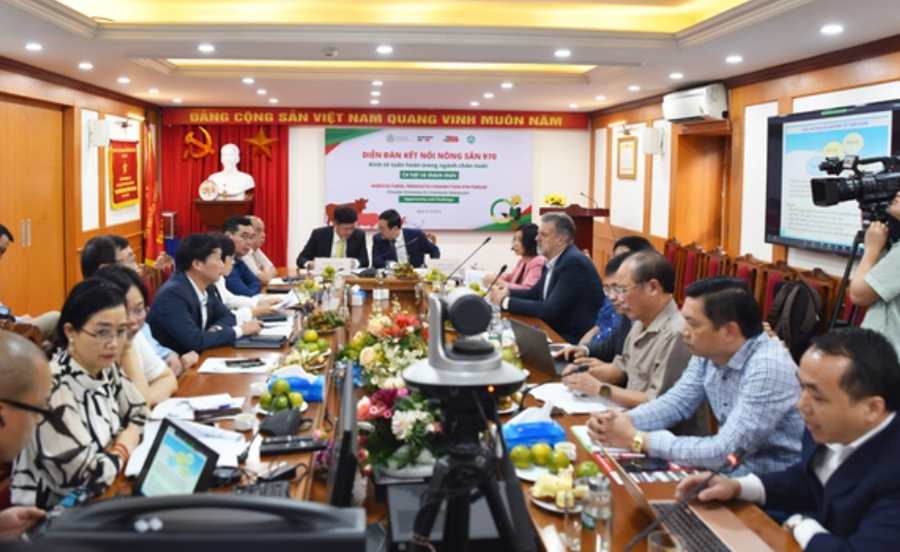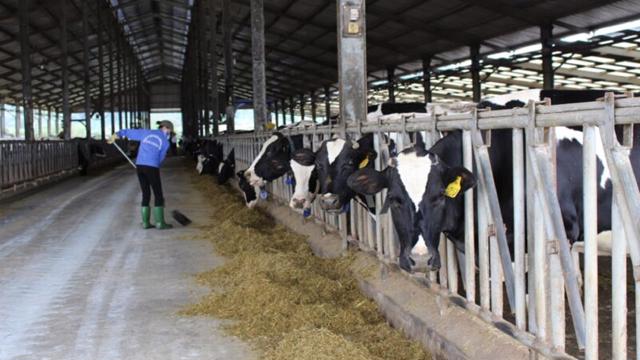[ad_1]
On March 21, the Department of Agriculture and Rural Development and the Agribusiness Advisory Group (ARG) of the Australian Center for International Agricultural Research in Vietnam (ACIAR) organized the Forum “Circular economy in Vietnam”.
SEVERAL CURRENT LIVESTOCK MODELS
According to Mr. Duong Tat Thang, Director of the Department of Animal Husbandry (Ministry of Agriculture and Rural Development), we have a vast animal husbandry system with a total herd of about 30 million pigs, over 500 million poultry and over 12 million cattle. The value of the entire livestock industry in 2022 is estimated at $23.7 billion.
In fact, the livestock industry has built a system of legal documents and technical standards similar to the world and the region. However, the director of the Department of Animal Production also acknowledged that there are still certain limitations such as consumption issues, market connectivity, epidemics, impact on emissions and animal waste treatment.
In this context, circular economy is an inevitable trend that brings practical benefits such as: B. increasing value, increasing animal products and harmonizing long-term advantages between livestock and agriculture.
“The core principle of the circular economy in animal production is to reduce costs, consume input materials, reduce output emissions, process and reuse animal waste and agricultural by-products, and create a closed loop between different industries such as animal husbandry, cultivation, fisheries, processing technology”, stressed Mr. Thang.
At the forum, many delegates exchanged views on the implemented circular economy models in livestock farming. Referring to the large animal farm model, Dr. Nguyen The Hinh, Deputy Head of Agriculture Project Management Committee, said that there are currently three main technologies: treatment of solid waste by manure separators; gas waste treatment by biogas generators; Liquid waste treatment through irrigation system (effluent after biogas through filter system).
In recent years, the Low Carbon Agriculture Support Project (LCASP) has built models in 10 project provinces with positive initial results and has invested in manure separators on large livestock farms with over 2000 pigs/cows and an irrigation system with biogas wastewater.
Large farms all achieve profit margins in excess of 20%, payback periods of 5-6 years. Piloting the model on a number of pig farms over 5,000 head in size achieves a win rate of up to 60%, payback time of 2-3 years.

Mr. Pham Vinh Son, General Manager of TH Group’s Green Fertilizer Company, said that TH is currently adopting a number of technologies including flushing and discharge technology in a closed pipe system; Separation system imported from Germany; rapid soil regeneration system with biobuffer to kill harmful bacteria and microorganisms for the herd.
In particular, liquid waste, while containing many organic matter useful to plants, is a difficult resource to treat because it depends on many factors such as weather, feed inputs, microorganisms, etc. TH Group has invested in waste treatment plants utilizing full anaerobic technology and oxidation ditches utilizing microbial products and biological products, thereby promoting anaerobic treatment processes and nitrogenous wastewater and livestock manure to produce organic fertilizer.
SEVERAL OBSTACLES AND POINTS HAVE TO BE REMOVED
Mr. Nguyen Tri Cong, chairman of the Dong Nai Livestock Association, said there are still many obstacles and bottlenecks in developing livestock production towards a circular economy. That is, at present, for recirculating agricultural production units, by-products of this industry are used as raw materials for other industries, but they are intertwined with the provisions of the Environmental Protection Act and the Environmental Protection Act.
“Cow farming is currently growing at a high rate, but we have no grazing land. They want to use farm by-products as feed for cows, but when they go to farm processing plants to buy residues but transport them, they get caught because they are considered waste under environmental law. Buying animal manure for fertilizer processing is also difficult to transport because the environmental law dictates that animal manure is waste,” Mr. Cong addressed the issue.
Mr. Cong went on to say that the Livestock Law stipulates that when infected with diseases, animals, livestock and poultry must be destroyed by burial. It will take a long time to destroy and decompose this form, any farm that wants to restore production will take a long time, up to a dozen years. He suggested that the heat treatment method can be applied at a temperature of 100 degrees Celsius, which can be reused as food for other pets.
In order to advance the development of the circular economy in animal husbandry, Dr. Nguyen Van Bac, permanent representative of the National Center for Agricultural Advisory Services in the South, suggested promoting the application of research and technical advances.
“There is a need to focus on research into technologies for treating waste as fertilizer and treating agricultural by-products as animal feed. There are two core technologies: microorganisms and insects.”
Dr. Nguyen Van Bac, Permanent Representative of the National Center for Agricultural Advisory Services in the South.
DR. North emphasizes two core technologies. The first, Microbiological technology plays an extremely important role in direct manure treatment, indirect manure treatment and microbiology in animal nutrition with the aim of reducing waste and increasing profitability.
Monday, Insect application technology is developing strongly, especially in the field of circular economy. As an example of earthworms: “1 ton of earthworms can process 30 tons of manure within a month. The waste from earthworms is very suitable for use in cultivation and has a high economic value.
“The Department of Livestock Production has just announced the addition of black soldier flies, another livestock species that may be used in livestock farming. Studies by scientists show that 1 kg of black soldier fly larvae is capable of processing 10 kg of organic waste within 15 days. There have been many studies by scientists on oats using black soldier fly larvae in breeding swifts to create a premise to promote the development of black soldier fly in livestock farming towards a circular economy,” said Dr Bac …
Dr. Nguyen Anh Phong – Director of the Information Center’s Institute of Policy and Strategy for Agriculture and Rural Development (IPSARD) offers some solutions.
The first, There is a need to build a legal corridor and standardize the circular economy in the agricultural sector to perfect mechanisms and guidelines to set standards for production and marketing.
Monday, Formulating mechanisms and policies to promote and provide incentives for companies and production cooperatives to adopt circular economy technologies.
Tuesday, Connections and cooperation in research, application and technology transfer must be promoted at home and abroad.
Wednesday, TPromotion of digitization and development of a database system, analysis of data on the circular economy.
[ad_2]
Source link

